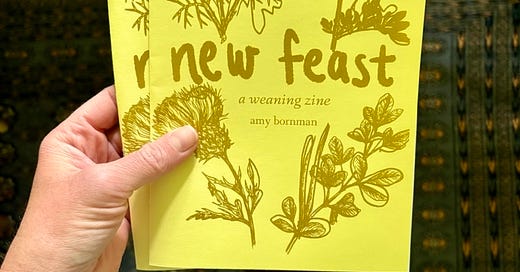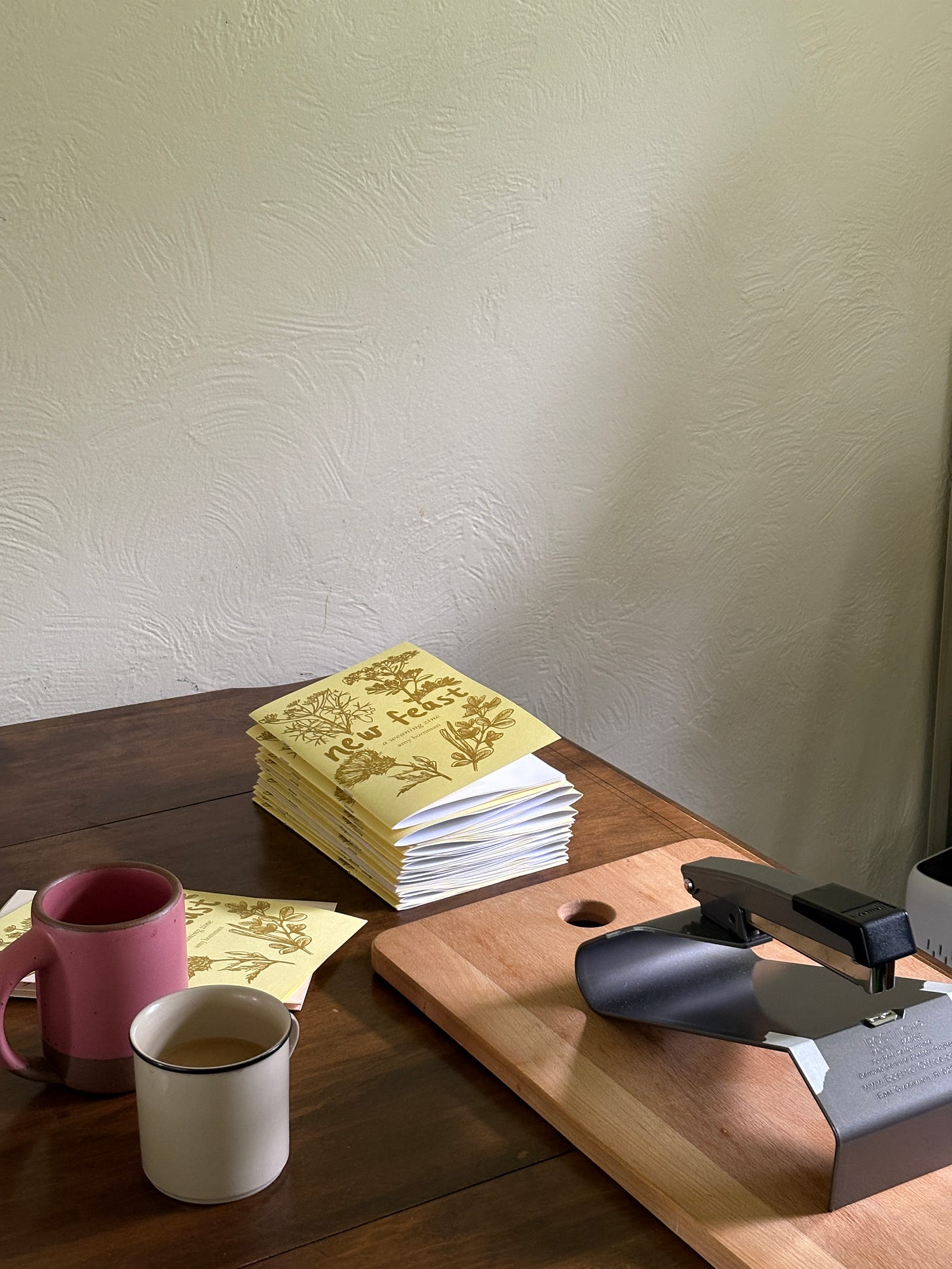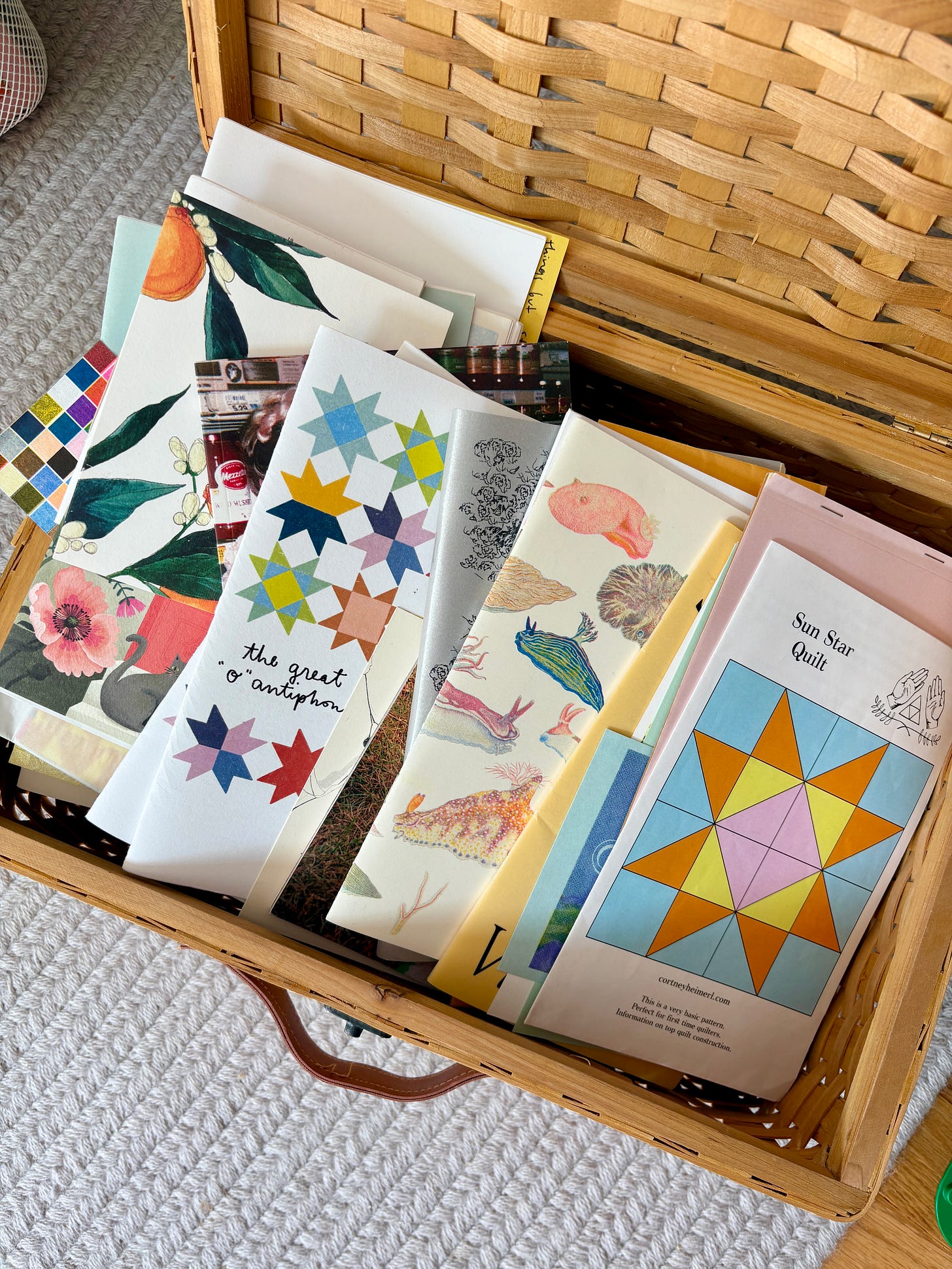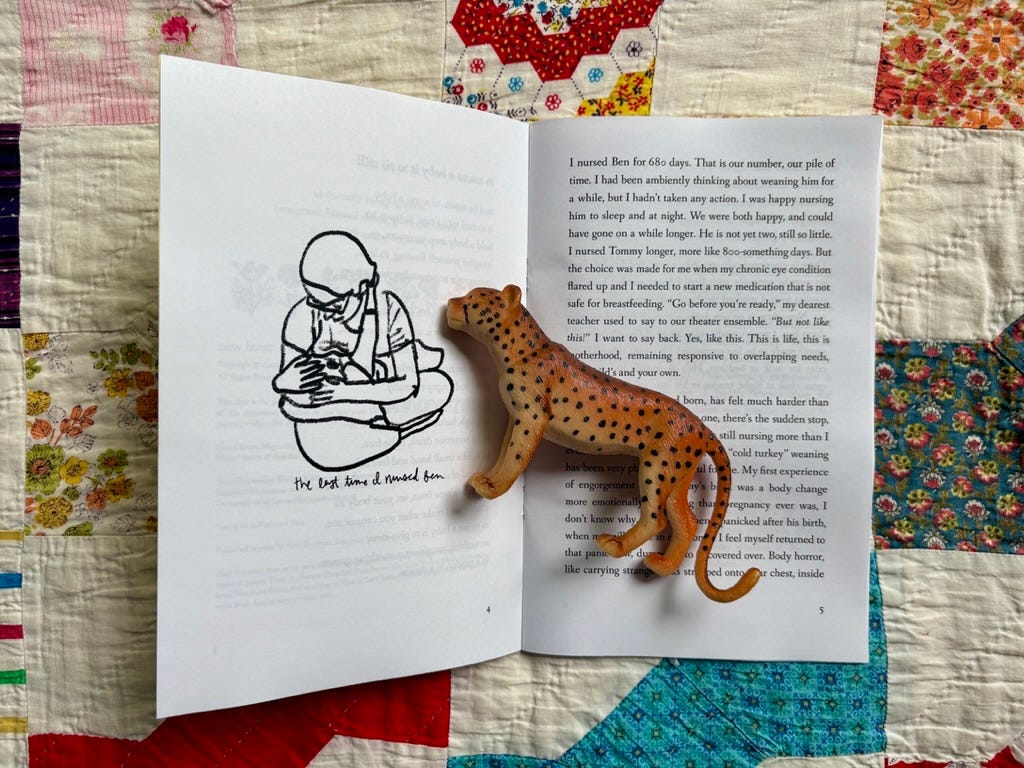I’ve just crossed through the passageway of weaning my second baby. It happened abruptly — my doctor told me that breastfeeding is not safe with a new medication I need to take to treat a chronic eye condition that I wish I didn’t have in the first place. A sudden stop so I could start the eye drops that would save my eye from damage. I don’t want to do this right now, I thought. But here we go.
Ben is almost two. He was still nursing to sleep and throughout the night, which we were both comfortable with. I probably wouldn’t have weaned for a while longer, and it would have been very gradual if I had my choice. But, I didn’t have a choice, and he didn’t either. He was sad, but not as sad as I was. Weaning is a hormonally significant experience in the body, a kind of crash. I braced myself for impact. I’m still bracing — a sudden stop takes a while to resolve, both physically and emotionally.
There’s more to the story, more to unwind and unfurl — which is why I made a new zine. A weaning zine. The first of its kind? Who knows. I started writing the essay that became the zine thinking I might post it here on substack, but I quickly swerved toward publication, furiously shaping it into a manuscript and then a publication over the course of a single day. Deep focus, determination. Satisfaction!
(Buy the zine here! — more details at the end of this essay)
For a while now I have turned to zines as the preferred way to publish some of my most tender writing about motherhood. Weaning is vulnerable! I feel vulnerable within it! I felt that some extra care needed to be taken with how to share this writing, and so much of my other most vulnerable writing has felt the same. After my second baby’s birth, I challenged myself to spent a year publishing six new zines for a series called “A Year Postpartum.” I wanted to document this time in our lives in some durable and meaningful way, and I wanted to do that in a way that fit within my life as caregiver to two small children and small business owner on maternity leave. A way that felt like a safe place to put my tender ongoing feelings about a tender time.
I could have tucked all that writing (some of my best, I feel!) away for some kind of book proposal to try to pitch to editors (possibly never to see the light of day). I could have published in here on substack either for free or behind a paywall. But, neither of those options felt satisfying to me. I wanted more than something that only exists on the internet, and I wanted more even than a traditionally published book that would take years to come to fruition, most likely to ultimately let me down due to all sorts of things that are out of my control. No, I wanted to turn my writing from this tender time into little books myself, in my own timing, on my own terms. I wanted, for lack of a better phrase, to own the means of production! I wanted immediacy, I wanted control, I wanted elegance, stack of folded paper. I wanted to feel my words and my labor, hold them in my hands. I wanted something more personal than a book or a blog post. I wanted zines, beautiful ones. So that’s what I made!
I called that publishing project Imaginary Lake. Then, after that first year of making zines, I took an indefinite break. I wasn’t sure when I would publish a zine again. Next pregnancy? Some other milestone? I was waiting for the right feeling to arise. Turns out weaning broke the dry spell — that makes perfect sense! These huge shifts need particular containers! No ordinary substack post, no languishing manuscript.
Since even before I became a mom, I’ve been a bit obsessed with the ever shifting literary tradition of writing about motherhood. I read just about every published book that engages motherhood that I can get my hands on, and I have also been a devoted reader of a handful of very beautifully written “mom blogs” (that very much surpass the diminutive connotation that comes with the word “blog.”) It means a lot to me to contribute in my own way to this literature of motherhood according to my circumstance and capacity. But how? I’d place one of my traditionally published books in that category (and hope there will be more when the time is right) — but I feel so excited about the way that zines can contribute to a greater literary tradition too.
Zines feel like magical objects to me. The small collection of zines I have, made by friends and artists I admire, feels more precious to me than my collection of books — probably because they are handmade, because they are that much more personal, and distinctive. I keep my collection in a particular wicker basket along with other special paper memorabilia, and I love pulling it out and touching each zine. If my house was on fire, I’d leave my books and grab this basket. Zines are irreplaceable, ephemeral and enduring, both at once. You can often read a zine in a single sitting, take it all in in one long sip. You hold a zine in your hands, it is a real and tangible thing.
I want to leave a paper trail. My writing about that precious postpartum year, this zine about weaning, it means so much to me that it will exist on someone’s shelf, in someone else’s wicker basket. Something to read, share, hang onto, give as a gift. A precious object. Possibly even an heirloom? These are heirloom words! I want them to survive after me, proceed beyond me, on terms I define, printed on paper I have touched and folded myself. I think a lot about Emily Dickinson sending handwritten poem drafts to her friends in the mail along with an oak leaf or pressed flower. Zines feel so much like that to me. Something very precious, sent away in good faith, for safekeeping. There are and have been lots of reasons to distribute zines — can we add expanding literary tradition to the list?
Zine-making seems to be growing right now, surely in response to the only increasing disembodiment of the internet’s ubiquity, and even the encroachment of A.I. Zines are deeply human, defined by the limitations of super small scale publishing, the limitations of people who are real people! Who are not robots, who are not corporations, who are not marketers, who are not trying to go viral or become a bestseller. I have come to love and befriend my limitations. My own life’s particularities. They make me who I am. Motherhood is rife with limitations! What works for me may not work for you or anyone else, and that’s what’s so special about figuring out what to do with the things that are in you to make! But, I can see the impulse to publish things by yourself and often for yourself spreading. I recently shared a post about turning my personal google doc diary into a zine that’s just for me — that’s my most read and shared post on substack EVER! (I embedded it below this paragraph!) We, who are now citizens of the internet whether we want to be or not, long for tangibility, things we can hold in our hands. Maybe that’s print books. Maybe it’s printed out pages. (I saw a picture on notes of someone who printed out a bunch of substack newsletters and took them to the park to read on paper! I’m, frankly, obsessed with that!) And, maybe it’s zines!
I made my google-doc diary into a zine
I write a diary as close to daily as I can — but daily is a very loose approximation of my frequency in personal writing. I aspire to The Artist’s Way-esque morning pages, and at times I can get somewhere near there, but in this season of life with little children and many demands, a few lines written a few times a week feels like a victory. For a long …
My writing about these hugely tender thresholds I’ve found in motherhood feels too precious to only exist on the internet. I write about these things for myself — safekeeping for my memories, in the form that appeals to me. But I want to offer the writing up and let it exist in the world — on my shelf, my friend’s, a strangers. Reading literature about motherhood has been a critical part of my own matrescence. I was just thinking about this anew as I read The Wilderness by Aysegul Savas, a book length essay about the first forty days after birth. I could read this story endlessly, I found myself thinking as I drank in this exquisite and strange little book. In literature, I want to hear endless birth stories, endless postpartum stories, endless weaning stories, as many as people are willing to labor over and, offer up, and thoughtfully, publish. If a zine can make that happen, then that zine is magical. For the motherhood-writing literary genre to continue to grow in legitimacy and nuance, for it to be inclusive of established writers and those who are not consistently welcomed by traditional publishing but still have rigorous work to share, we need to welcome mothers to contribute real writing from within the experience, whatever form that takes. Blogs, substacks, zines, and books. We need to write them, and then get them to readers. We need motherhood to be read, and to see our experiences reflected back to us in the literature that is celebrated. That can only happen if we write it and share it, even if that means publishing it ourselves. I may be idealistic about all of this, actually I’m sure that I am. But I think idealism is how most books are made, really.
It has meant so much to me to make zines and send them to readers, knowing they will be read, cherished, and carried into the future. My own strange literature, firmly within the tradition if you look at the long story of people writing and sharing writing. Folded paper, an oak leaf, read and then tucked into your special wicker basket, forever.
Want to read the zine? It’s called New Feast. There’s a limited edition print version that I’ll send to you in the mail, or a downloadable version that includes a digital pdf to read on a screen and a printable file so you can print and fold the zine yourself at home.
The print zine is $8, and the download is $5 — think of it like a more cozy paywall! Where you get a thing! I have very mixed feelings about exchanging money for writing — as someone with an extremely small amount of disposable income I really can’t afford to pay for very many subcription-based newsletters or even a surplus of books. That’s why this newsletter is free and will probably remain that way. But zines cost money to produce, and the labor of producing zines feels more significant than sending occasional essays via email. Still, I want these words to be read and kept and enjoyed, and I know times are financially weird for almost all of us, so I also want to offer a third option! If you can’t afford $8 or $5, just send me an email (amybornman@gmail.com), and I’ll be happy to send you a zine or the download for the price of the stamp or whatever you’d like to pay, free included! No questions asked! The zine economy has plenty of wiggle room for abundance. Zines for everyone! Especially weaning zines!
I also wrote about weaning my older son years ago on Substack — if you’d like to read that essay it’s here!
Buy me a coffee/leave a tip! Here’s my Kofi page!
Share this essay on notes, like and leave a comment, and/or send it to a friend who you think would like it! All of this stuff truly means a lot, and makes it more fun to share writing here for free!
Read my books, Broken Waters, There is a Future, and How To Sew Clothes.
Check out my other zines, all written and published during my first year postpartum with my second baby.
I love to hear from you! Leave a comment to share a thought, or send me an email in reply to this one!
in zines and weans!
xoxo,
Amy










